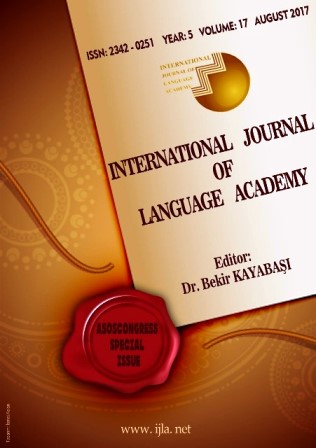KAVRAMSAL AKTARIM: İNGİLİZCE’Yİ YABANCI DİL OLARAK ÖĞRENEN TÜRK ÖĞRENCİLERİN KONUMSAL EDATLARIN KULLANIMI
Author :
Abstract
Bu betimsel çalışma bilginin ana dildeki uzamsal konumlanmasının ikinci dile aktarılıp aktarılmadığı ve eğer aktarılıyorsa bunun nasıl gerçekleştiğini anlamayı hedeflemektedir. Çalışmanın ilk amacı öğrencilerin yaptığı ortak sözdizimsel hataları ortaya çıkarmak ve onları uygun kategorilere yerleştirmektir. Daha sonra, bu yaygın hataların üzerinde öğrencilerin birinci dillerinin (Türkçe) etkileri Bada’nın (1989) Türkçe ve İngilizce hal ekleri ve edatlarının karşılaştırması temel alınarak araştırılmıştır. Kırkgöz’ün (2010) “ekleme”, “çıkarma” ve “yanlış kullanım” kategorilerine dayalı yapılan hata analizleri en yaygın hata türünün “yanlış kullanım” olduğunu ve bunu “çıkarma” kategorisinin takip ettiğini göstermiştir. Sonuçlar Jarvis’in (2007) Kavramsal Aktarım Hipotezi ile uyumlu olarak kavramların zihinsel organizasyonunun birinci dilden ikinci dile aktarıldığı izlemini uyandırmaktadır.
Keywords
Abstract
This descriptive study is an attempt to understand if and how the spatial positioning of information in L1 is transferred to L2 contexts. The first aim was to discern any commonalities among the syntactic errors that learners commit and put them under certain categories. Next, the influence of the learners’ first language (Turkish) was sought on their prevalent errors in the light of Bada’s (1989) comparison of Turkish and English case system and prepositions. An analysis of errors with reference to Kırkgöz’s (2010) categorization of addition, omission and misuse errors showed that the most common error type was misuse followed by omission errors. Results suggest the transfer of the mental organization of concepts from L1 to L2 (English) complying with the Conceptual Transfer Hypothesis of Jarvis (2007).
Keywords
- Alonso, A., M. (2009). Conceptual transfer regarding locative prepositions: The cases of in, on, and at. The Grove: Working Papers on English Studies, 16, 45-62.
- Bada, E. (1989). Interference: Turkish case-markers‟ transfer to English prepositional utterances. Unpublished M.A. thesis. Çukurova University, Adana.
- Bowerman, M. (1996). The origin of children„s spatial semantic categories: cognitive versus linguistic determinants. In. J. J. Gumperz & S. C. Levinson (Eds). Rethinking Linguistic Relativity, (145–176), Cambridge: CUP.
- Carroll, M., Murcia-Serra, J., Watorek, M., & Bendiscioli, A. (2000). The relevance of information organization to second language acquisition studies: The descriptive discourse of advanced adult learners of German. Studies in Second Language Acquisition, 22, 441–466.
- Chan, A. Y. W. (2004). Syntactic Transfer: Evidence from the Interlanguage of Hong Kong Chinese ESL Learners. The Modern Language Journal, 88, 56-74.
- Elkılıc , G. (2012). Mother tongue traces of Turkish university students on composition papers written in English. Procedia-Social and Behavioral Sciences, 47, 656–664.
- Fathman, A. & LoCoco, V. (1989). Word order contrasts and production in three target languages. In H. Dechert & M. Raupach (eds.), Transfer in language production. Norwood, NJ: Ablex Publishing Corporation, pp. 159-170.
- Hohenstein, J., Eisenberg, A. & Naigles, L. (2006). Is he floating across or crossing afloat? Cross-influence of L1 and L2 in Spanish–English bilingual adults. Bilingualism: Language and Cognition, 9 (3), 249-261.
- Isurin, L. (2005). Proceedings of the 4th International Symposium on Bilingualism, Ed. James Cohen, Kara T. McAlister, Kellie Rolstad, and Jeff MacSwan, 1115-1130. Somerville, MA: Cascadilla Press.
- Jarvis, S. & Odlin, T. (2000). Morphological type, spatial reference, and language transfer. Studies in Second Language Acquisition, 22, 535-556.
- Jarvis, S. (2007). Theoretical and Methodological Issues in the Investigation of Conceptual Transfer. Vigo International Journal of Applied Linguistics, 4, 43-71.
- Jarvis, S. & Pavlenko, A. (2008). Crosslinguistic Influence in Language and Cognition. New York: Routledge.
- Kellerman, E. (1995). Crosslinguistic influence: Transfer to nowhere? Annual Review of Applied Linguistics, 15, 125–150.
- Kırkgöz, Y. (2010). An analysis of written errors of Turkish adult learners of English. Procedia: Social and Behavioral Sciences, 2, 4352-4358.
- Levinson, S., Meira, S. & The Language and Cognition Group (2003). 'Natural concepts' in the spatial topological domain-adpositional meanings in crosslinguistic perspective: An exercise in semantic typology. Language, 79(3), 485-516.
- MacWhinney, B. (1992). Transfer and competition in second language learning. In R. J. Harris (ed.), Cognitive processing in bilinguals, pp. 371–390. Oxford: Elsevier Science Publishers.
- Meriläinen, L. (2010). Language transfer in the written English of Finnish students. Journal of Applied Language Studies, 4(1), 51-64.
- Müller, N. (1998). Transfer in bilingual first language acquisition. Bilingualism: Language and Cognition, 1, 151–171.
- Odlin, T. (1989). Language transfer: Cross-linguistic influence in language learning. Cambridge: Cambridge University Press.
- Odlin, T. (2005). Crosslinguistic influence and conceptual transfer: What are the concepts? Annual Review of Applied Linguistics, 25, 3–25.
- Pederson, E. Danziger, E. Wilkins, D. Levinson, S. Kita, S. & Senft, G. (1998). Semantic typology and spatial conceptualization. Language, 74(3), 557-589.
- Schumann, J. (1986). Locative and directional expressions in basilang speech. Language Learning, 36, 277–294.
- Selinker, L. (1972). Interlanguage. International Review of Applied Linguistics. 10, 209- 231.
- Yip, V. (1995). Interlanguage and learnability: From Chinese to English. Amsterdam: John Benjamins.
- Yıldız, M. (2016). Contrastive analysis of Turkish and English in Turkish EFL learners‟ spoken discourse. International Journal of English Studies, 16(1), 57-74.
- Zobl, H. (1982). A direction for contrastive analysis. The comparative study of developmental sequences. TESOL Quarterly, 16(2), 183-196.





